“Why These Temples?” Ensign, Aug. 1974, 37
Special Issue: Temples
Why These Temples?
There are only a few places on earth where man’s questions about life receive the answers of eternity.
Was there ever a man who, in a time of quiet introspection, has not pondered the solemn mysteries of life? Has he not asked himself: “where did I come from? Why am I here? Where am I going? What is my relationship to my Maker? Will death rob me of the treasured associations of life? What of my wife and children? Will there be another existence after this, and, if so, will we know one another there?”
The answers to these questions are not found in the wisdom of men. They are found only in the revealed word of God. Temples of The Church of Jesus Christ of Latter-day Saints are sacred structures in which these and other eternal questions are answered. Each is dedicated as a house of the Lord, a place of holiness and peace, shut apart from the world, where truths are taught and ordinances are performed that bring knowledge of things eternal and motivate the participant to live with understanding of his divine inheritance as a child of God and an awareness of his potential as an eternal being.
The stately new temple, recently completed on the outskirts of Washington, D.C., is the 16th such structure operated by the Church. These buildings, different from the thousands of regular Church houses of worship scattered over the earth, are unique in purpose and function from all other religious edifices. It is not the size of these buildings, or their architectural beauty, that make them so. It is the work that goes on within their walls.
In addition to the Washington Temple, other Latter-day Saint temples are found in the western area of the United States and in Hawaii, Canada, New Zealand, England, and Switzerland. Two such structures were built in the early years of the Church but were abandoned when the Latter-day Saints were driven from place to place under the cruel bigotry of a less tolerant age.
The designation of certain buildings for special ordinances, as distinguished from regular places of worship, is not new. This was the practice in ancient Israel, where the people worshipped regularly in the synagogues. Their more sacred place was, first, the tabernacle in the wilderness with its Holy of Holies, and then a succession of temples, where special ordinances were performed and where only those who met the required qualifications could participate in these ordinances.
So it is today. Prior to the dedication of a temple, The Church of Jesus Christ of Latter-day Saints invites the public to go through the building and inspect its various facilities. But when it is dedicated it becomes the house of the Lord, vested with a character so sacred that only members of the Church in good standing are permitted to enter. It is not a matter of secrecy. It is a matter of sanctity.
The work that goes on in these buildings sets forth God’s eternal purposes with reference to man, God’s child and creation. For the most part it is concerned with the family, with each of us as members of God’s eternal family and with each of us as members of earthly families. It is concerned with the sanctity and eternal nature of the marriage covenant and family relationships.
It affirms that each man and woman born into the world is a child of God, endowed with something of his divine nature. The repetition of these basic and fundamental teachings has a salutary effect upon those who receive them, for as the doctrine is enunciated in language both beautiful and impressive, the participant comes to realize that since every man is a child of a heavenly Father, then each is a member of a divine family and hence every man is his brother.
When asked by the scribe, “Which is the first commandment of all?” the Savior replied, “… Thou shalt love the Lord thy God with all thy heart, and with all thy soul, and with all thy mind, and with all thy strength: this is the first commandment.
“And the second is like, namely this, Thou shalt love thy neighbor as thyself. …” (Mark 12:28, 30–31.)
The teachings set forth in modern temples give powerful emphasis to this most fundamental concept of man’s duty to his Maker and to his brother. Sacred ordinances amplify this ennobling philosophy of the family of God. They teach that the spirit within each of us is eternal, in contrast with the body that is mortal. They not only give understanding of these great truths but also motivate the participant to love of God and encourage him to demonstrate a greater neighborliness toward others of our Father’s children.
Accepting the premise that man is a child of God, then there is divine purpose in mortal life. Here again, revealed truth is taught in the house of the Lord. Earth life is part of an eternal journey. We lived as spirit children before we came here. The scriptures bear testimony of this as witness the word of the Lord to Jeremiah: “Before I formed thee in the belly I knew thee; and before thou camest forth out of the womb I sanctified thee, and I ordained thee a prophet unto the nations.” (Jer. 1:5.)
We come into this life as children of mortal parents and as members of families. Parents are partners with God in bringing to pass his eternal purposes with reference to his children. The family, therefore, is a divine institution, the most important both in mortality and in eternity.
Much of the work that goes on within temples is concerned with the family. Basic to an understanding of its meaning is recognition of the fact that even as we existed as children of God before we were born into this world, so also shall we continue to live after death, and the treasured and satisfying relationships of mortality, the most beautiful and meaningful of which are found in the family, may continue in the world to come.
Marriage partners who come to the house of the Lord and partake of its blessings are joined not only for the period of their mortal lives but for all eternity, under authority not only of the law of the land that joins them until death parts them but also of the eternal priesthood of God, binding in heaven that which is bound on earth. The couple so married has the assurance of divine revelation that their relationship and that of their children will not end with death but will continue in eternity, provided they live worthy of that blessing.
Was there ever a man who truly loved a woman, or a woman who truly loved a man, who did not pray that their relationship might continue beyond the grave? Has a child ever been buried by parents who did not long for the assurance that their loved one would again be theirs in a world to come? Can anyone believing in eternal life doubt that the God of heaven would grant his sons and daughters that most precious attribute of life, the love that finds its most meaningful expression in family relationships? No, reason demands that the family relationship shall continue after death. The human heart longs for it. The God of heaven has revealed a way whereby it may be secured. The sacred ordinances of the house of the Lord provide for it.
But all of this would appear to be selfish indeed if the blessings of these ordinances were available only to those who are now members of The Church of Jesus Christ of Latter-day Saints. The fact is that the opportunity to come into the temple and partake of its blessings is open to all who will accept the gospel and be baptized into the Church. For this reason the Church carries forward an extensive missionary program in much of the world and will continue to expand this program as widely as possible, for it has the responsibility under divine revelation to teach the gospel to “every nation, kindred, tongue, and people.”
But there are uncounted millions who have walked the earth and who have never had the opportunity to hear the gospel. Shall they be denied such blessings as are offered in the temples of the Church?
Through living proxies who stand in behalf of the dead, the same ordinances are available to those who have passed from mortality. In the spirit world they then are free to accept or reject those earthly ordinances performed for them, including baptism, marriage, and the sealing of family relationships. There must be no compulsion in the work of the Lord, but there must be opportunity.
This vicarious work constitutes an unprecedented labor of love on the part of the living in behalf of the dead. It makes necessary a vast undertaking of genealogical research to find and identify those who have gone before. To assist in this research, the Church coordinates a genealogical program and maintains research facilities unmatched in all the world. Its archives are open to the public and have been used by many who are not members of the Church in tracing their forebears. This program has been praised by genealogists throughout the world and has been utilized by various nations as a safeguard of their own records. But its primary purpose is to afford members of the Church the resources needed to identify their dead ancestors that they might extend to them the blessings that they themselves enjoy. They in effect say to themselves, “If I love my wife and children so dearly that I want them for all eternity, then should not my grandfather and great-grandfather and other forebears have opportunity to receive the same eternal blessings?”
And so these sacred buildings are scenes of tremendous activity, quietly and reverently carried forward. They call to mind a part of the vision of John the Revelator wherein are recorded this question and this answer: “… What are these which are arrayed in white robes? and whence came they?
“… These are they which came out of great tribulation, and have washed their robes, and made them white in the blood of the Lamb.
“Therefore are they before the throne of God, and serve him day and night in his temple. …” (Rev. 7:13–15.)
Those who come to these holy houses are arrayed in white as they participate therein. They come only on recommendation of their local ecclesiastical authorities, having been certified as to their worthiness. They are expected to come clean in thought, clean in body, and clean in dress to enter the temple of God. As they enter they are expected to leave the world behind them and concentrate on things divine.
This very exercise, if such it may be called, carries with it a reward of its own, for who in these times of stress would not welcome an occasional opportunity to shut out the world and enter into the Lord’s house, there to ponder quietly the eternal things of God? These sacred precincts offer the opportunity, available nowhere else, to learn of and reflect on the truly meaningful things of life—our relationship to deity and our eternal journey from a preexistent state through this life and on to a future estate where we shall know and associate one with another, including our own loved ones and our forebears who have preceded us and from whom has come our inheritance of things of the body, mind, and spirit.
Surely these temples are unique among all buildings. They are houses of instruction. They are places of covenants and promises. At their altars we kneel before God our Creator and are given promise of his everlasting blessings. In the sanctity of their appointments we commune with him and reflect on his Son, our Savior and Redeemer, the Lord Jesus Christ, who served as proxy for each of us in a vicarious sacrifice in our behalf. Here we set aside our own selfishness and serve for those who cannot serve themselves. Here we are bound together in the most sacred of all human relationships—as husbands and wives, as children and parents, as families under a sealing that time cannot destroy and death cannot disrupt.
These sacred buildings were constructed even during those dark years when the Latter-day Saints were relentlessly driven and persecuted. They have been built and maintained in times of poverty and prosperity. They have come of the vital faith of an ever-growing number who bear witness of a living God, of the resurrected Lord, of prophets and divine revelation, and of the peace and assurance of eternal blessings to be found only in the house of the Lord.
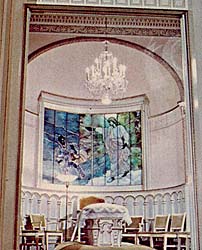
1. Salt Lake Temple sealing room. (© LDS.)
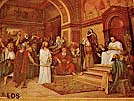
2. Detail of St. George Temple painting of Christ before Pilate. (© LDS.)

3. Hawaii Temple bride’s room. (© LDS.)

4. Baptismal font in Provo Temple. (© LDS.)
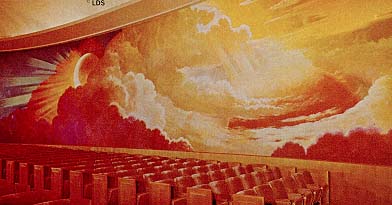
5. Los Angeles Temple creation room. (© LDS.)
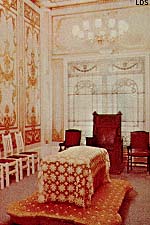
6. Logan Temple sealing room. (© LDS.)

7. Freestanding circular staircase in Manti Temple. (© LDS.)

8. Salt Lake Temple celestial room. (© LDS.)

9. Manti Temple hallway. (© LDS.)

10. Los Angeles Temple world room. (© LDS.)
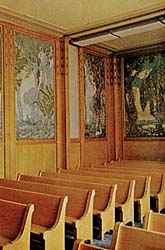
11. Alberta Temple garden room. (© LDS.)

12. St. George Temple garden room. (© LDS.)
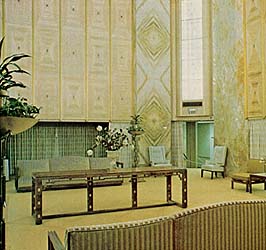
13. Oakland Temple celestial room. (© LDS.)
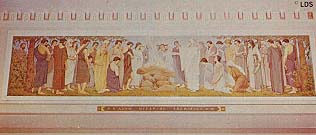
14. Detail of Alberta Temple mural of Adam offering sacrifice. (© LDS.)

15. Doors to the Swiss Temple. (© LDS.)

16. Mesa Temple painting of Christ healing the sick. (© LDS.)

17. Alberta Temple celestial room. (© LDS.)

18. Salt Lake Temple garden room. (© LDS.)

19. Manti Temple celestial room. (© LDS.)

20. Salt Lake Temple assembly room. (© LDS.)

21. Logan Temple ceiling. (© LDS.)

22. Mesa Temple celestial room. (© LDS.)
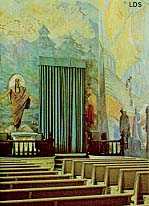
23. Manti Temple world room. (© LDS.)
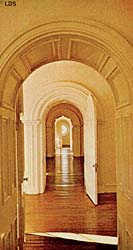
24. Doorway in the St. George Temple. (© LDS.)

25. Manti Temple sealing room. (© LDS.)
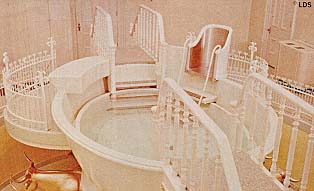
26. Logan Temple baptismal font. (© LDS.)

27. Salt Lake Temple spiral staircase. (© LDS.)

28. Hawaii Temple baptismal font. (© LDS.)

29. Doorway in the Mesa Temple. (© LDS.)

30. Idaho Falls Temple baptismal font. (© LDS.)
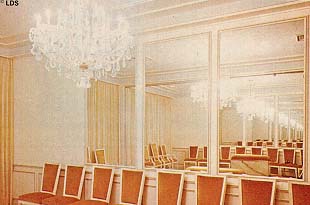
31. Ogden Temple sealing room. (© LDS.)

32. Idaho Falls Temple celestial room. (© LDS.)
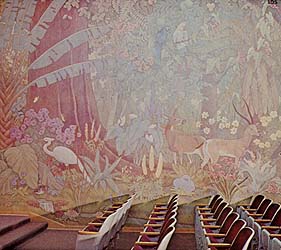
33. Idaho Falls Temple garden room. (© LDS.)

34. Hawaii Temple celestial room. (© LDS.)

35. St. George Temple painting of the First Vision. (© LDS.)
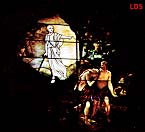
36. Salt Lake Temple stained glass window of Adam and Eve. (© LDS.)
Pictures copyright by the Corporation of the President, The Church of Jesus Christ of Latter-day Saints